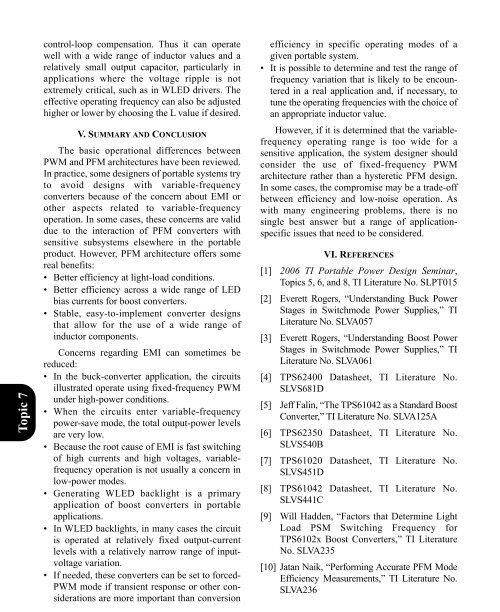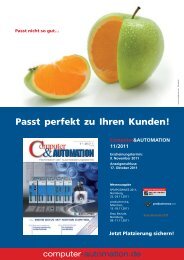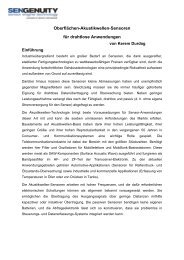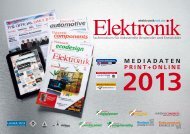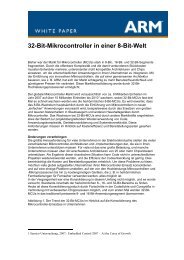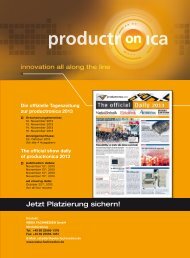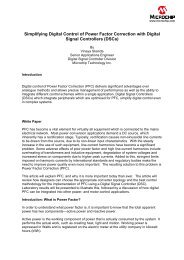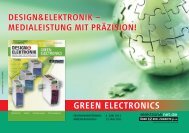PWM and PFM Operation of DC/DC Converters ... - next!-Community
PWM and PFM Operation of DC/DC Converters ... - next!-Community
PWM and PFM Operation of DC/DC Converters ... - next!-Community
You also want an ePaper? Increase the reach of your titles
YUMPU automatically turns print PDFs into web optimized ePapers that Google loves.
Topic 7<br />
control-loop compensation. Thus it can operate<br />
well with a wide range <strong>of</strong> inductor values <strong>and</strong> a<br />
relatively small output capacitor, particularly in<br />
applications where the voltage ripple is not<br />
extremely critical, such as in WLED drivers. The<br />
effective operating frequency can also be adjusted<br />
higher or lower by choosing the L value if desired.<br />
V. SUMMARY AND CONCLUSION<br />
The basic operational differences between<br />
<strong>PWM</strong> <strong>and</strong> <strong>PFM</strong> architectures have been reviewed.<br />
In practice, some designers <strong>of</strong> portable systems try<br />
to avoid designs with variable-frequency<br />
converters because <strong>of</strong> the concern about EMI or<br />
other aspects related to variable-frequency<br />
operation. In some cases, these concerns are valid<br />
due to the interaction <strong>of</strong> <strong>PFM</strong> converters with<br />
sensitive subsystems elsewhere in the portable<br />
product. However, <strong>PFM</strong> architecture <strong>of</strong>fers some<br />
real benefits:<br />
• Better efficiency at light-load conditions.<br />
• Better efficiency across a wide range <strong>of</strong> LED<br />
bias currents for boost converters.<br />
• Stable, easy-to-implement converter designs<br />
that allow for the use <strong>of</strong> a wide range <strong>of</strong><br />
inductor components.<br />
Concerns regarding EMI can sometimes be<br />
reduced:<br />
• In the buck-converter application, the circuits<br />
illustrated operate using fixed-frequency <strong>PWM</strong><br />
under high-power conditions.<br />
• When the circuits enter variable-frequency<br />
power-save mode, the total output-power levels<br />
are very low.<br />
• Because the root cause <strong>of</strong> EMI is fast switching<br />
<strong>of</strong> high currents <strong>and</strong> high voltages, variablefrequency<br />
operation is not usually a concern in<br />
low-power modes.<br />
• Generating WLED backlight is a primary<br />
application <strong>of</strong> boost converters in portable<br />
applications.<br />
• In WLED backlights, in many cases the circuit<br />
is operated at relatively fixed output-current<br />
levels with a relatively narrow range <strong>of</strong> inputvoltage<br />
variation.<br />
• If needed, these converters can be set to forced-<br />
<strong>PWM</strong> mode if transient response or other considerations<br />
are more important than conversion<br />
efficiency in specific operating modes <strong>of</strong> a<br />
given portable system.<br />
• It is possible to determine <strong>and</strong> test the range <strong>of</strong><br />
frequency variation that is likely to be encountered<br />
in a real application <strong>and</strong>, if necessary, to<br />
tune the operating frequencies with the choice <strong>of</strong><br />
an appropriate inductor value.<br />
However, if it is determined that the variablefrequency<br />
operating range is too wide for a<br />
sensitive application, the system designer should<br />
consider the use <strong>of</strong> fixed-frequency <strong>PWM</strong><br />
architecture rather than a hysteretic <strong>PFM</strong> design.<br />
In some cases, the compromise may be a trade-<strong>of</strong>f<br />
between efficiency <strong>and</strong> low-noise operation. As<br />
with many engineering problems, there is no<br />
single best answer but a range <strong>of</strong> applicationspecific<br />
issues that need to be considered.<br />
VI. REFERENCES<br />
[1] 2006 TI Portable Power Design Seminar,<br />
Topics 5, 6, <strong>and</strong> 8, TI Literature No. SLPT015<br />
[2] Everett Rogers, “Underst<strong>and</strong>ing Buck Power<br />
Stages in Switchmode Power Supplies,” TI<br />
Literature No. SLVA057<br />
[3] Everett Rogers, “Underst<strong>and</strong>ing Boost Power<br />
Stages in Switchmode Power Supplies,” TI<br />
Literature No. SLVA061<br />
[4] TPS62400 Datasheet, TI Literature No.<br />
SLVS681D<br />
[5] Jeff Falin, “The TPS61042 as a St<strong>and</strong>ard Boost<br />
Converter,” TI Literature No. SLVA125A<br />
[6] TPS62350 Datasheet, TI Literature No.<br />
SLVS540B<br />
[7] TPS61020 Datasheet, TI Literature No.<br />
SLVS451D<br />
[8] TPS61042 Datasheet, TI Literature No.<br />
SLVS441C<br />
[9] Will Hadden, “Factors that Determine Light<br />
Load PSM Switching Frequency for<br />
TPS6102x Boost <strong>Converters</strong>,” TI Literature<br />
No. SLVA235<br />
[10] Jatan Naik, “Performing Accurate <strong>PFM</strong> Mode<br />
Efficiency Measurements,” TI Literature No.<br />
SLVA236


